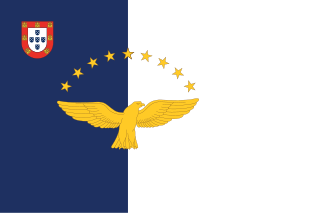
The Azores, officially the Autonomous Region of the Azores, is one of the two autonomous regions of Portugal. It is an archipelago composed of nine volcanic islands in the Macaronesia region of the North Atlantic Ocean, about 1,400 km (870 mi) west of Lisbon, about 1,500 km (930 mi) northwest of Morocco, and about 1,930 km (1,200 mi) southeast of Newfoundland, Canada.

The Azores bullfinch, also known as the São Miguel bullfinch, or locally in Portuguese as the priolo, is a threatened passerine bird in the true finch family. It is endemic to São Miguel Island, in the Azores archipelago of Macaronesia in the North Atlantic Ocean.

Picconia is a genus of two species of flowering plants in the family Oleaceae, found in the laurel forests habitat of Macaronesia.

The Azores noctule is a species of bat found in the dry forests of the Azores. It is the only species of mammal endemic to the Azores. It has been recorded on most of the islands of the Azores, and remains common on some but is rare on others. Its numbers are threatened due to habitat loss caused by humans, and the remaining populations are quite fragmented. It is known to roost in hollowed-out trees, buildings, and caves.

Juniperus brevifolia, the Azores juniper, is a species of juniper, endemic to the Azores, where it occurs at altitudes of 240–800 metres, rarely up to 1,500 m (4,900 ft). It is closely related to Juniperus oxycedrus of the Mediterranean region and Juniperus cedrus of the neighboring Macaronesian islands. It is threatened by habitat loss.

Picconia azorica, locally known as pau-branco, is a species of Picconia common to the majority of islands of the Portuguese archipelago of the Azores, where it is endemic. It can grow to a medium-sized tree, though it is usually found in the form of a shrub. It is threatened by habitat loss.

Ponta dos Rosais is a promontory located along the northwestern coast of the parish of Rosais, municipality of Velas, on the island of São Jorge in the Portuguese archipelago of the Azores.
Falbouria is a genus of flies in the family Dolichopodidae. It contains only one species, Falbouria acorensis, which is endemic to the Azores. The genus was originally named Balfouria by Octave Parent in 1933; it was renamed to Falbouria by C. E. Dyte in 1980, after the name Balfouria was found to be preoccupied by the snail genus Balfouria Crosse, 1884.

The Botanical Garden of Faial is an ecological garden, component of the Faial Nature Park, established in 1986 to educate and protect the biodiversity common on Faial, an island of the Azores archipelago.

The Azores wood pigeon, Columba palumbus azorica is an endemic subspecies of the common wood pigeon, located in the Atlantic Azores islands of Portugal. This endemic subspecies is the only live pigeon present in the laurel forest habitat of the Azores Islands.

Pseudanchomenus is a beetle genus in the family of ground beetles (Carabidae). Its only described species, Pseudanchomenus aptinoides, is endemic to the Azores archipelago.

Euphorbia stygiana is a species of evergreen shrub in the family Euphorbiaceae, endemic to several islands of the Azores. It has a critically endangered subspecies with only 20 known remaining mature individuals in the wild.

The Azores temperate mixed forests is a temperate broadleaf and mixed forests ecoregion of southwestern Europe. It encompasses the Azores archipelago in the Atlantic Ocean. These volcanic islands are an autonomous region of Portugal, and lie 1500 km west of the Portuguese mainland.

Praia Islet is a highly vegetated uninhabited islet located approximately 1.5 kilometres away from the town of Praia off the eastern coast of the island of Graciosa in the Portuguese archipelago of the Azores. Along with Baixo Islet to its south, Praia Islet is one of two main breeding places of Monteiro's storm petrel, an endemic marine bird of the Azores.

Vila Franca Islet is a vegetated uninhabited islet located off the south-central coast of the island of São Miguel in the Portuguese archipelago of the Azores. The entire islet and surrounding waters constitute a protected nature reserve, while remaining a popular destination for swimming and cliff diving.

Megabalanus azoricus, the Azorean barnacle, is a species of large barnacle in the family Balanidae. It is endemic to Macaronesia: the Azores, Madeira, the Canary Islands, and Cape Verde. It is the largest and third most common shallow water barnacle of the Azores, where it is heavily exploited for food and has a high commercial value since the colonization of the islands. It was included in the 100 species for priority management within Macaronesia. It is a thoracopodal filter feeder and the majority are hermaphrodites. It is more abundant in the first 3 m (9.8 ft) on the low intertidal and infralittoral rocky shores. The empty shells of the barnacles are a vital habitat for the blennies Parablennius ruber, P. incognitus and Coryphoblennius galerita as they provide shelter and substrata for egg deposition during reproduction. A large number of invertebrate species also use the empty shells. Although present throughout the archipelago, it is more abundant in the eastern islands. It has a genetic similarity with Megabalanus tintinnabulum. Some crucial features of the M. azoricus species are digonic hermaphroditism in sessile adults, development of planktotrophic larvae, dependence on exposed rocky shores in the intertidal habitat, and insular distribution restricted to the northeastern Atlantic oceanic islands.

Trechus terrabravensis is a beetle species in the family Carabidae endemic to Terceira Island, Azores, Portugal.
Tarphius rufonodulosus is a species of ironclad beetle endemic to the island of Santa Maria in the archipelago of the Azores, Portugal.
Tarphius pomboi is a species of ironclad beetle endemic to the island of Santa Maria in the archipelago of the Azores, Portugal.
Tarphius serranoi is a species of ironclad beetle endemic to the island of Santa Maria in the archipelago of the Azores, Portugal.

















